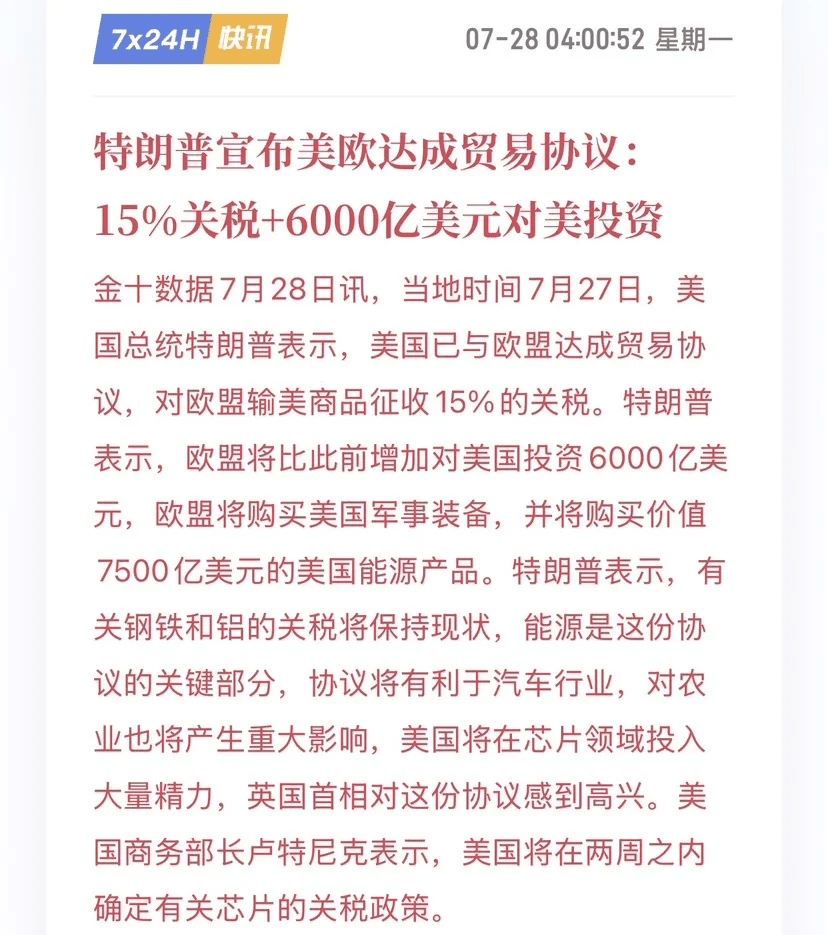According to Jin10 data on July 28, local time on July 27, Trump announced that the US and the EU reached a trade agreement, bringing new variables to the cryptocurrency circle. In the current context of the close interconnection between the global economy and financial markets, its potential impact on the cryptocurrency market deserves analysis.
I. Core Content of the US-EU Trade Agreement
The agreement mainly includes: a 15% tariff on goods exported to the US from the EU; the EU increasing its investment in the US by $600 billion while purchasing US military equipment and $750 billion in energy products; maintaining the status quo on steel and aluminum tariffs; and the US focusing on the chip sector, determining chip tariff policy within two weeks.
II. Initial Shock to the Global Economy and Financial Markets
As major global economies, the trade agreement between the US and EU will reshape the trade landscape between both sides, altering capital flows and industrial expectations. Financial markets are sensitive to reactions, and the cryptocurrency market may also find it hard to remain unaffected.
The US dollar exchange rate may be affected. If the EU increases investment and procurement from the US, it may temporarily boost the demand for dollars. Since cryptocurrencies are often priced in dollars, the appreciation of the dollar may put downward pressure on Bitcoin and others—raising the cost of purchasing with other currencies.
III. Specific Impact Path on the Cryptocurrency Circle
(1) Risk Asset Linkage Effect
As a high-risk asset, cryptocurrencies are closely related to the risk appetite of traditional financial markets. If the agreement enhances risk appetite and capital shifts toward high-risk assets, cryptocurrencies are likely to benefit; if it triggers economic uncertainty and market risk appetite declines, cryptocurrencies may face selling pressure.
(2) Changes in Capital Flow
The EU's $600 billion investment in the US will divert global funds. The cryptocurrency circle is relatively small, and if the traditional financial market attracts more funds, the cryptocurrency circle may face capital withdrawal, leading to a correction in cryptocurrencies. At the same time, the layout of the US chip sector attracts tech capital, putting pressure on the cryptocurrency circle regarding funding and talent competition, which may affect project advancement.
(3) Regulatory and Policy Expectations
The US-EU trade agreement involves policy coordination, which may trigger a chain reaction of global policy adjustments. The regulatory environment for cryptocurrencies is complex. If the US and EU subsequently introduce coordinated policies for digital assets, it may have a demonstration effect on regulation in the cryptocurrency circle.
IV. Responses and Outlook from the Cryptocurrency Circle
In the face of uncertainty, participants in the cryptocurrency circle need to pay attention to macro dynamics. Investors should strengthen risk awareness and allocate assets reasonably; project teams need to focus on technological innovation to enhance application value.
In the long run, the development of cryptocurrencies is inseparable from the evolution of the global economic ecosystem. The US-EU trade agreement is a microcosm of the adjustment of the global economic landscape, and the cryptocurrency circle needs to find opportunities within adaptation. If it can provide efficient solutions in areas such as cross-border payments, its value will be further highlighted.
In summary, the agreement brings challenges and opportunities to the cryptocurrency circle. Participants need to remain vigilant and keep up with changes to grasp the rhythm in a complex environment.
#ATM #美国与欧盟达成关税协议 #ETH #BTC #BNB创新高
